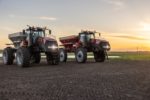Advertise Follow Us
Items Tagged with 'spreaders'
ARTICLES
High-Tech Tools To Manage No-Till Residue From The Combine
New technologies are coming online to help no-tillers spread residue evenly across ever-growing header widths, and set the stage for successful no-till planting the following season.
Read More
Livestock, Covers Add Diversity For Enterprising No-Tiller
Byron Richard’s once wheat-dominated farm in North Dakota is now home to many different crops — including livestock — after his commitment to no-till practices.
Read More
No-Till Notes
Fix Little Things To Boost Combine Performance
Checking belts, chains, elevators, fluids and more are important tasks before no-tillers take to the fields for harvest.
Read More
No-Till Makes Effective Use Of Limited Moisture
Rotations are the key to turning out good no-till profits in limited rainfall areas.
Read More
Successful No-Tilling Starts At Harvest
Effective residue management is the first step to minimize numerous no-till concerns.
Read More
Try These Proven No-Till Residue Management Tricks
Regardless of where you farm or the crops you grow, study these solid residue management lessons from no-tillers growing high-yielding grain crops.
Read More










